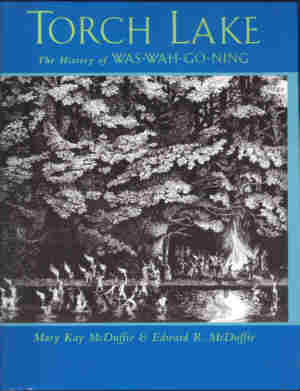New Book Explains Torch Lake Named for Indians Spearing Fish by Torchlight
|
||||||||||
| Printer Friendly Story View |

Betty Beeby's pen and ink drawing on the book cover reproduces a painting on birchbark by Katie Bechtold McCutcheon in 1909.
The history from glacial times of one of Michigan's most popular lakes is documented in a new book, "Torch Lake: The History of Was-Wah-Go-Ning," by Mary Kay McDuffie and Edward R. McDuffie.
The McDuffie's hail -- of course -- from the village of Bellaire on Torch Lake, where the family has lived for four generations. Who better to write of an Antrim County icon that has inspired waves of visitors to enjoy the clear waters flowing into Elk Lake and fed by the east arm of Grand Traverse Bay?
Much like the cold depths of Lake Michigan, treasures of Michigan bygone are sunk in the near 600 foot waters of Torch Lake -- sailing ships and lumbering equipment, and who knows what else -- are preserved for eternity.
Around the shore of Torch Lake lie ancient artifacts, the chert that was used by the early tribes for tools and weapons, and remnants of the trees that brought the lumbermen and pioneers.
How did Torch Lake get its name? Betty Beeby, designer of cover for the book, explains: "The early settlers did see the Native American Indians with their birch bark torches all along the shore. That attracted the fish; thus, 'Torch Lake' was well named."
This 436 page, exceptionally well produced glossy compendium of Torch Lake lore and photos, will not sit long on your coffee table --it will be picked up and read cover to cover for the fascinating tales of early habitation stretching from the the retreat of the Valders glacier to halcyon post-World War II days when the end of gasoline rationing brought tourists by the thousands.
There are 673 photographs, drawings, maps and geological charts in the book. "The book is a must for those interested in Michigan history, and will become a standard for those anxious to learn the details of local geology, lumbering, pioneer families, settlement farming and the development of the North Woods tourist industry," comments Charles E. Cleland, author of "Rites of Conquest and The Place of the Pike."
The book is more than just a history of a lake: it is a history of Michigan focusing on the lake area's transition from Ojibwa (Chippewa) Indian settlements like Anish-Qua-Go-Nabe to the 1830s of Rev. Peter Daughterty, the first white settler and on into the modern era.


The Saginaw Trail plays a prominent part since it was the wooded highway from southern Michigan to the Saginaw River, with one branch of the trail leading to Grand Traverse Bay (and Torch Lake) and another branch to Mackinaw.
"From the trail system, it was possible to walk from southern Michigan right to Torch Lake," state the authors. "The Dixie Highway, still in existence today between Eastport and Norwood, was a part of that system. Early sailing vessels, and then steamers, soon offered speedy and comfortable travel by boat, bringing Europeans north to begin settling the Torch Lake area."
Prior to the Treaty of 1836, a permit from the Indian agent was required even to enter the Torch Lake area, that was part of the District of Michillimackinac. In the Washington Treaty, the Ottawa and Chippewa Indians ceded about 13 million acres to the U.S. for about 16 cents an acre along with trade goods, schools, medical care and forgiveness of a debt of $350,000 allegedly owed to fur traders.
Thirty-three year old Rev. Daugherty, a Presbyterian missionary, was first to arrive at Torch Lake in 1839 along with Rev. John Flemming and an interpretor. Daugherty built a shack, later torn down when the Mission Church was established on Mission Peninsula.
The original name Megissee (after a Chippewa chief called eagle) County was changed to Antrim County in 1843 as surveying progressed and settlers began to filter into the area.
The book may be obtained by contacting the the McDuffies at Megissee County Publications, 1340 S.E. Torch Lake Dr., Bellaire, MI 49615, phone 231-377-7307. Cost is $60. ###
| Printer Friendly Story View |
|
|

Dave Rogers |
|
|
|
Printer-Friendly Story View
0200 Nd: 04-21-2024 d 4 cpr 0
12/31/2020 P3v3-0200-Ad.cfm
SPONSORED LINKS
12/31/2020 drop ads P3v3-0200-Ad.cfm


